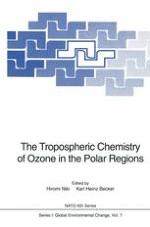1993 | OriginalPaper | Buchkapitel
Polar Sunrise Studies
verfasst von : Jan Bottenheim
Erschienen in: The Tropospheric Chemistry of Ozone in the Polar Regions
Verlag: Springer Berlin Heidelberg
Enthalten in: Professional Book Archive
Aktivieren Sie unsere intelligente Suche, um passende Fachinhalte oder Patente zu finden.
Wählen Sie Textabschnitte aus um mit Künstlicher Intelligenz passenden Patente zu finden. powered by
Markieren Sie Textabschnitte, um KI-gestützt weitere passende Inhalte zu finden. powered by
The polar night is long and cold. Locations such as Alert at the northern edge of Ellesmere Island (82° N) do not receive any sunlight from late September until the beginning of March, and the average ambient temperature is normally below −30 °C during that time. This fact has interesting consequences for the chemistry that can occur in the ambient air at this part of the world. Most notably, the absence of sunlight effectively prevents the primary photochemical production of atomic and free radical compounds that initiate many of the important atmospheric chemical processes. Furthermore, the comparatively low temperatures generally lead to slower bimolecular reactions. This also leads to a drastically reduced water content of the air. All these factors combined imply that whenever airborne contaminants are somehow transported to the Arctic, their lifetime is considerably longer than at climatically more moderate mid-latitude regions. Combined with the absence of efficient transport routes out of the Arctic basin, it has the effect that the arctic atmosphere serves as a holding reservoir: a buildup of contaminants is expected — and observed. This picture changes at the time when the sun reappears. More active chemistry once again becomes possible through the photochemical production of reactive atomic and free radical compounds. Polar sunrise studies are specifically concerned with attempts to catch the chemical changes that take place during this transition from dark-phase to sunlight-irradiated chemistry.
